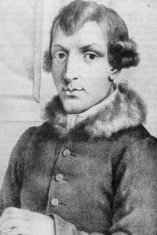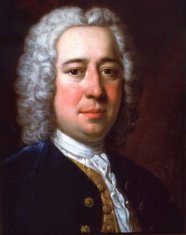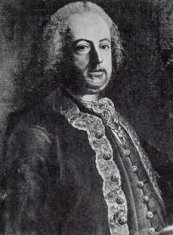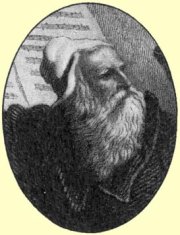|
|
Nicola Porpora (Composer) |
|
Born: August 17, 1686 - Naples, Italy
Died: March 3, 1768 - Naples, Italy |
|
Nicola (Antonio) Porpora was an Italian composer of Baroque operas and teacher of singing, whose most famous singing student was the castrato Farinelli. He graduated from the music conservatory Poveri di Gesù Cristo of his native city, where the civic opera scene was dominated by Alessandro Scarlatti.
Nicola Porpora's first opera, Agrippina, was successfully performed at the Neapolitan court in 1708. His second, Berenice, was performed at Rome. In a long career, he followed these up by many further operas, supported as maestro di cappella in the households of aristocratic patrons, such as the commander of military forces at Naples, the prince of Hesse-Darmstadt, or of the Portuguese ambassador at Rome, for composing operas alone did not yet make a viable career. However, his enduring fame rests chiefly upon his unequalled power of teaching singing. At the Neapolitan Conservatorio di Sant'Onofrio and with the Poveri di Gesù Cristo he trained Farinelli, Caffarelli, Salimbeni, and other celebrated vocalists, during the period 1715-1721. In 1720 and 1721 he wrote two serenades to librettos by a gifted young poet, Metastasio, the beginning of a long, though interrupted, collaboration. In 1722 his operatic successes encouraged him to lay down his conservatory commitments.
After a rebuff from the court of Charles VI at Vienna in 1725, Nicola Porpora settled mostly in Venice, composing and teaching regularly in the schools of La Pietà and the Incurabili. In 1729 the anti-Händel clique invited him to London to set up an opera company as a rival to Händel's, without success, and in the 1733-1734 season, even the presence of his pupil, the great Farinelli, failed to save the dramatic company in Lincoln's Inn Fields (the "Opera of the Nobility") from bankruptcy.
An interval as Kapellmeister at the Dresden court of the Elector of Saxony from 1748 ended in strained relations with his rival in Venice and Rome, the hugely successful opera composer Johann Adolph Hasse and his wife, the prima donna Faustina, and resulted in Nicola Porpora's departure in 1752. From Dresden he went to Vienna, where he gave music lessons to the young Joseph Haydn, who lived with Porpora as accompanist and in the character of a valet, but allowed later that he had learned from the maestro "the true fundamentals of composition". Then Porpora returned in 1759 to Naples.
From this time Nicola Porpora's career was a series of misfortunes: his florid style was becoming old-fashioned, his last opera, Camilla, failed, his pension from Dresden stopped, and he became so poor that the expenses of his funeral were paid by a subscription concert. Yet at the moment of his death Farinelli and Caffarelli were living in splendid retirement on fortunes largely based on the excellence of the old maestro's teaching.
A good linguist, who was admired for the idiomatic fluency of his recitatives, and a man of considerable literary culture, Nicola Porpora was also celebrated for his conversational wit. Besides some four dozen operas, there are oratorios, solo cantatas with keyboard accompaniment, motets and vocal serenades. Among his larger works, his 1720 opera Orlando, one mass, his Venetian Vespers, and the serenata Arianna in Nasso (1733) have been recorded . |
|
Criticisms |
|
Nicola Porpora was deprived of dramatic genius, his operatic style shows a complete absence of variety. He only wrote arias for his operas, and all of them have been composed in the same fashion. In the scores for Meride e Selinunte there are 29 arias and only one (final) choir that is 21-measures long. Of these arias, 8 are written in F Major, of which seven are in common time marked allegro and one contains three measures with basso continuo and viola obbligata.
He was well-renowned as vocal composer, yet his work Semiramide riconosciuta shows his great skill as orchestrator: its instrumentation is unusually ample, often in ten parts, with flutes, oboes, bassoons, French horns and trumpets that are listed and usually always very present. Nicola Porpora shows that not only does he know all the innovations in the technique of instrumentation, he also proposes color and impasti in continuous mutation. The work is filled with brief phrases, that pass from tutti to soli and vice-versa gently with much difference from the famous technique a terazze (which juxtaposes sections with fixed timbre and intensity). Vocal parts are extremely difficult, and if Mirteo indulges himself in moderate and amorous arias (maybe to showcase Farinelli's expressive ability), great virtuosity is focused on Ircano's aria (one is often stupefied with continuous jumps, even in an interval of twelfth in Talor che il veno freme (I, 14), an aria with vibrant semiquaver figurations in the strings section. Impressive is the virtuosity of Il ciel mi vuole oppresso (III,3), always accompanied by amazing and continuous replies from the brass). Semiramide, whose vocality is broken, filled with doubt, introspective, has a great pathetic-pastoral moment (in an unusual 12/8 measure of Il pastor se torna aprile (II,5), grand aria with transverse flutes obbligati), which in the ample chant of the queen achievs tumults of changeable, unexpected, intense harmony.
In his youth Nicola Porpora had much gaiety, spirit and a ready answer, but with ageing he had outbursts of bad mood that was excusable because of his extreme poverty. He was well-read in Latin and Italian literature, wrote poetry and spoke French, German and English. |
|
J.S. Bach Connection |
|
Vocal and instrumental pieces by a great variety composers must have been included in the weekly series of "ordinary" concerts by the Collegium Musicum, but it is impossible to reconstruct, even in the broadest outlines, any of the more than five hundred two-hour programs for which J.S. Bach was responsible. Pertinent performing materials from the 1730's are extremely sparse; among the traceable compositions are four orchestral overtures by Johann Bernhard Bach; the Cantata Armida Abbandonata (HWV 105) by Georg Frideric Handel; the Concerto Grosso in F minor, Op. 1, No. 8, by Pietro Locatelli; three Italian cantatas (Dal primo foco in cui penai, Sopra un colle fiorito, and Ecco l'infausto lido) by Nicola Porpora; and the cantata Se amor con un contento by Alessandro Scarlatti. (Glöckner 1990, pp 89f.) Additionally, "Mr. Bach de Leipzig" is found among the subscribers to Georg Philipp Telemann's Nouveaux Quatuors (flute quartets), published in Paris in 1738, which suggests that he wanted the pieces for the Collegium series. Although these few works and composers cannot be considered representative at all, they confirm that the repertoire was both instrumental and vocal, that Italian solo cantatas played a role, and that the newest kind of music (such as the Porpora cantatas and the G.P. Telemann quartets) was introduced.
Christoph Wolff: Johann Sebastian Bach The Learned Musician (W.W. Norton & Company, 2000), pp. 333, 501 |
|




|
|
Source: Mostly Wikipedia Website
Contributed by Aryeh Oron (October 2008) |
|
Works arranged / copied / performed by J.S. Bach |
|
c1734 J.S. Bach performed with his Collegium Musicum in Leipzig 3 of N. Porpora's Secular Cantatas: Dal primo foco cui penai, Sopra un colle fiorito, Ecco linfausto lido
Source: Gerlach Collegium Musicum Library to Breitkopf; Christoph Wolff: Johann Sebastian Bach The Learned Musician (W.W. Norton & Company, 2000), p. 333, 501 |
|
Links to other Sites |
|
Nicola Porpora (Wikipedia)
Porpora Project: Nicola Porpora
Nicola Porpora (Sojurn)
HOASM: Nicola (Antonio) Porpora |
Nicola Porpora (Britannica Online Encyclopedia)
Nicola Porpora Operas (Karadar)
Nicola Porpora (Answers.com) |
|
Bibliography |
| |
|
|